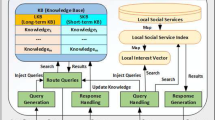Abstract
Recently, the growth of social network service (SNS, Facebook) has required the search technique to utilize its distinctive characteristic which links people to people. This paper discusses the design and implementation of GRAPPE which suggests the ranked list of optimal connecting routes between two people by interaction like SNS, phone calls, texts, mails. It is based on mutual intimacy index (MII) which indicate how closely two people are related. MII is calculated periodically when a user interact with other person by smartphone. In this study, we propose a simple two-ended search method for finding optimal routes between a source person and a destination person. For the real-time service it searches optimal path within 3 step-away relationship in human network that is effective in real life while existing services in SNS usually provide one-ended search on entire paths. Furthermore, we also use the pruning technique for efficient execution time.



Similar content being viewed by others
References
Drew, O., Constine, J., Taylor, C., Lunden, I.: Facebook Announces Its Third Pillar “Graph Search” That Gives You Answers, Not Links Like Google. TechCrunch, AOL Tech. http://techcrunch.com/2013/01/15/facebook-announces-its-third-pillar-graph-search/ (2013). Accessed 16 Sept 2014
Milgram, S.: The small world problem. Psychol. Today 2, 60–67 (1967)
Watts, D.J., Strogatz, S.H.: Collective dynamics of ’small-world’ networks. Nature 393, 440–442 (1998)
Christakis, N.A., Fowler, J.H.: Connected: The Surprising Power of Our Social Networks and How They Shape Our Lives. Back Bay Books, New York (2011)
Cheol-Min, L., Chang-Su, K., Kyung-Won, P., Hyun-Sook, A.: A study on business strategies and success factors of social network service and enterprises: focusing on representative SNS of Korea. J. Digit. Converg. 12(7), 177–187 (2014)
Kyung-Ja, P., Seong-Joon, P., Hee-Young, J.: Study on the use of SNS (social network service) for tasks: focus on the task-media fit. J. Digit. Converg. 12(2), 577–586 (2014)
Chen, L.-C., Kuo, P.-J., Liao, I.-E.: Ontology-based library recommender system using MapReduce. Clust. Comput. 18(1), 113–121 (2015)
Wu, J., Chen, L., Yu, Q., Kuang, L., Wang, Y., Wu, Z.: Selecting skyline services for QoS-aware composition by upgrading MapReduce paradigm. Clust. Comput. 6(4), 693–706 (2013)
Brandes, U.: A faster algorithm for betweenness centrality. J. Math. Sociol. 252001, 163–177 (2001)
van den Berg, P., Arentze, T., Timmermans, H.: A path analysis of social networks, telecommunication and social activity-travel patterns. Transp. Res. Part C 26, 256–268 (2013)
Goldberg, A.V., Harrelson, C.: Computing the shortest path: a search meets graph theory. In: Society for Industrial and Applied Mathematics, Proceedings of the sixteenth annual ACM-SIAM symposium on Discrete algorithms (2005)
Yoon-Su, J., Kun-Hee, H.: Big data processing scheme of distribution environment. J. Digit. Converg. 12(6), 311–316 (2014)
Nam-Gue, P., Sun-Bae, K.: A proposal for SmartTV development plan by applying big data analysis methodology. J. Digit. Converg. 12(1), 347–358 (2014)
Choi, K.-H., Oh, H.-H., Kwag, H.-J.: Network analysis using frequency of cross-citation and comparing citation index of accounting journals. J. Digit. Converg. 12(2), 143–149 (2014)
Luo, J., Dong, F., Cao, J., Song, A.: A context-aware personalized resource recommendation for pervasive learning. Clust. Comput. 13(2), 13–39 (2010)
Zhang, S., McCullagh, P., Zhang, J., Yu, T.: A smartphone based real-time daily activity monitoring system. Clust. Comput. 17, 1–11 (2013)
Bellman, R.: On a routing problem. DTIC Doc. 16, 87–90 (1956)
Dijkstra, E.: A note on two problems in connexion with graphs. Numer. Math. 1, 269–271 (1959)
Zhang, F., Jiping, L.: An algorithm of shortest path based on Dijkstra for huge data. In: Sixth International Conference on Fuzzy Systems and Knowledge Discovery 2009 (FSKD ’09), vol. 4, IEEE (2009)
Floyd, R.W.: Algorithm 97: shortest path. Commun. ACM 5(6), 345 (1962)
Hart, P.E., et al.: A formal basis for the heuristic determination of minimum cost paths. Syst. Sci. Cybern. 4(2), 100–107 (1968)
Johnson, D.B.: Efficient algorithms for shortest paths in sparse networks. J. ACM 24(1), 1–13 (1977)
Viterbi, A.J.: Error bounds for convolutional codes and an asymptotically optimum decoding algorithm. IEEE Trans. Inf. Theory 13(2), 260–269 (1967)
Jinha, K., Seung-Keol, K., Hwanjo, Y.: Scalable and parallelizable processing of influence maximization for large-scale social networks. In: IEEE 29th International Conference on Data Engineering (ICDE), pp. 266–277 (2013)
Kourtellis, N., Alahakoon, T., Simha, R., Iamnitchi, A., Tripathi, R.: Identifying high betweenness centrality nodes in large social networks. Soc. Netw. Anal. Min. 3, 899–914 (2013)
Shavitt, Y., Tankel, T.: Hyperbolic embedding of internet graph for distance estimation and overlay construction. IEEE/ACM Trans. Netw. 16(1), 25–36 (2008)
Song, H.H., et al.: Clustered embedding of massive social networks. In: Proceedings of the 12th ACM SIGMETRICS/PERFORMANCE joint international conference on Measurement and Modeling of Computer Systems (2012)
Klodt, P., et al.: Indexing Strategies for Constrained Shortest Paths over Large Social Networks. Universitat des Saarlandes (2011)
Sarma, A. D., et al.: A sketch-based distance oracle for web-scale graphs.In: Proceedings of the third ACM international conference on Web search and data mining, 401–410 (2010)
Zhao, X., Sala, A., Wilson, C., Zheng, H., Zhao, B.Y.: Orion: shortest path estimation for large social graphs. WOSN’10 1, 1–9 (2010)
Zhao, X., et al.: Efficient shortest paths on massive social graphs. In: 7th International Conference on Collaborative Computing: Networking, Applications and Worksharing (CollaborateCom), 2011. IEEE (2011)
Gubichev, A., T. Neumann: Path query processing on very large rdf graphs. In: Proceedings of the 14th International Workshop on the Web and Databases (WebDB) (2011)
Gubichev, A., et al.: Fast and accurate estimation of shortest paths in large graphs. In: Proceedings of the 19th ACM international conference on Information and knowledge management, ACM, 499–508 (2010)
Frank, E.: Pruning Decision Trees and Lists, PhD thesis, University of Waikato, Hamilton (2000)
Author information
Authors and Affiliations
Corresponding author
Rights and permissions
About this article
Cite this article
Keum, K., Nam, S., Kang, Y. et al. GRAPPE : a system for determining optimal connecting route to target person based on mutual intimacy index. Cluster Comput 18, 1117–1126 (2015). https://doi.org/10.1007/s10586-015-0458-4
Received:
Revised:
Accepted:
Published:
Issue Date:
DOI: https://doi.org/10.1007/s10586-015-0458-4




